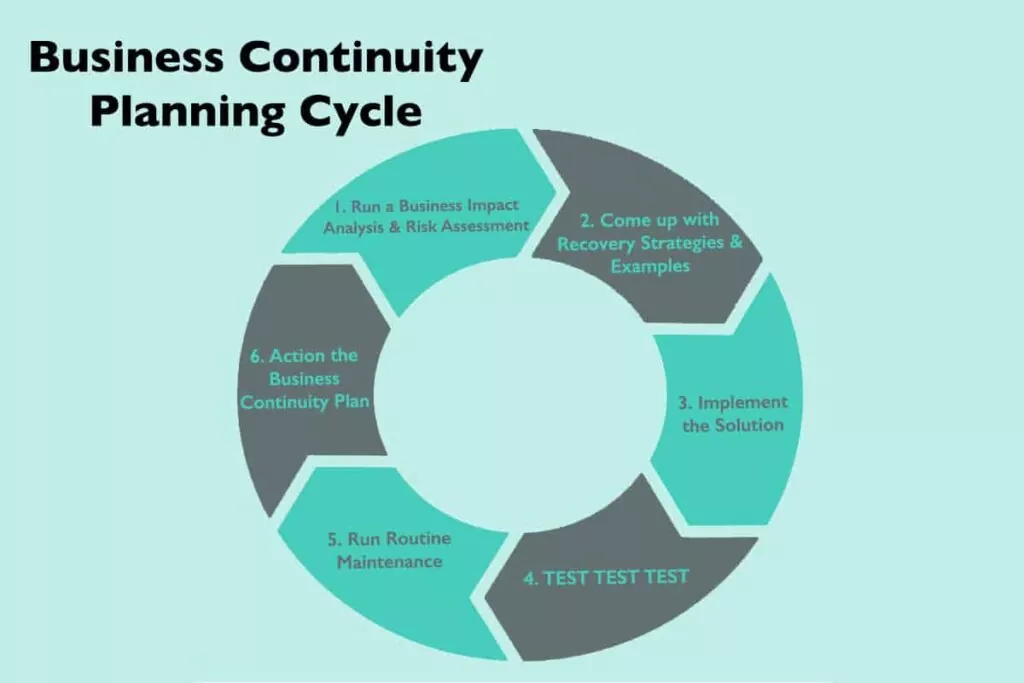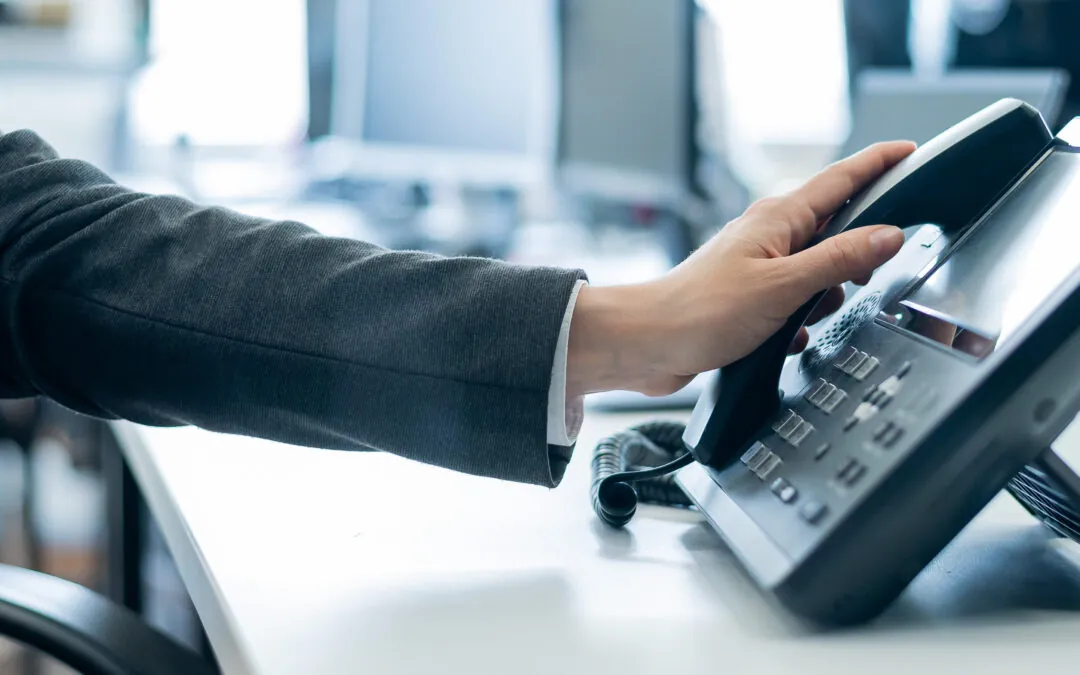It goes without saying that COVID-19 has disrupted this year on a global scale. While we’ve all been affected in different ways, businesses of all types and sizes have taken a big hit. When situations like COVID-19 happen, a business continuity plan is vital in order for organisations to protect themselves and their employees, while keeping the business running as normal. In this guide, we’ll explain what a business continuity plan is, why it’s important and give you tips on how to make your own plan.
What Is A Business Continuity Plan (BCP)?
Business continuity is a company’s ability to maintain or quickly resume its functions and practices during and after a disaster has occurred. This is done by having plans, scenarios and procedures in place that aim to prevent these kinds of disruptions and unpredictable events. These events range from environmental disruptions, network outages, cyber-attacks and… global pandemics.
This planning is known as business continuity planning. Business continuity planning is the process of creating systems of prevention and recovery to deal with threats or disasters. These are in place within a business so the company stays up and running during a potential problem and employees and clients are protected. The diagram below gives you a rough idea of how planning comes into play and affects the business.
How your business has reacted to COVID-19 is mainly down to your business continuity plan (BCP). People within your organisation – typically IT directors, HR managers and in some cases, Business Continuity Coordinators – will have drafted plans about how to deal with the current situation that we’re in.

Why do you need one?
COVID has thrown this commonly-asked question into the shade. “We’ll cope, we always do” or “It won’t happen to us” are easy things to say and think when a disaster doesn’t seem to be on the horizon. These are just a couple of frequent responses from businesses who don’t have a BCP in place. Disasters have no boundaries – whether you’re a start-up or a large corporation. Here are just a few reasons why having a BCP is vital for your business:
Understand, manage and assess any risks
Whether a disaster is happening or not, it’s good to be prepared with a plan for how your business is going to react. Having a BCP helps you to anticipate certain catastrophes and to understand what they might jeopardise or interfere with.
If you understand how you can manage a problem, and the order of processes, you’ll be able to tackle the issue and assess what’s going on and when you can go back to normal. This will also give your company peace of mind that if something were to happen, you’d be able to work efficiently and return to work as seamlessly as possible.
Protect your customers
When major disruption happens, customers and partners need to know that they’re protected and will be looked after. They need to be able to depend on you and if you give them the idea that you’re not prepared and won’t be able to assist them, they might look to move elsewhere.
The BCP will cover everything within the business, like your employees and office information, but it also concentrates on data handling. Whether it’s taking care of customer data or having a phone line open for them to contact you, your BCP helps protect customers and build your company reputation at the same time.
Ease stress and confusion for staff and colleagues
A BCP helps your staff understand what they’re doing while away from the office and their responsibilities during the incident. If staff know they’re being looked after and will have devices to continue their jobs while at home, they’ll feel less stressed and confused during a disaster. Not only this but staff will feel more loyal if they’re shown that their company is taking care of them.
Helps your business recover quicker
Response and recovery tend to overlap in a BCP. Overall, having a BCP helps you to plan and prepare for when things go back to normal and what happens next after the issue isn’t there anymore. This helps your business recover quicker and improve in all aspects of the business, including future business continuity plans. The graph below from GOV.UK illustrates this clearer.

Business Continuity & COVID-19
Now more than ever, business continuity planning has been high up on every company’s list. Noone expected COVID-19 and the affect it’s had on the world. A global pandemic was probably not included in many businesses’ list of scenarios but this unprecedented time (who else is sick of this phrase?) has taught us all to be more prepared and to consider every area – no matter how big.
Research conducted by Continuity Central looked into the business continuity management lessons businesses have learned from 2020. What they learned and continue to learn is that they must get the decision-making model right from the start to have a successful reaction to a disruption of this size. Acting quickly and securely, resetting and reimagining are key lessons that organisations have had to learn during this period.
How to make a business continuity plan
So, what should a business continuity plan include? Well, it depends on the disaster. Ideally, you should have different plans tailored to each potential problem. How you deal with a network issue isn’t going to be the same as how you react to an environmental issue and the recovery process won’t be the same either.
Before you start putting anything together, narrow down the type and amount of plans you want to have in place. Overall, you’re probably looking at creating 5-10 business continuity plans to cover these potential issues. We recommend having plans for the following:
- Major disruptions like a global pandemic
- Possible network problems like hacking, security breaches or bad internet connection
- Environmental issues like snow, flooding, storm damage – anything that prevents staff or customers from getting to the office
Now you have a rough idea of what type of plans you need to make; you can create your BCP. A BCP should concentrate on these three key elements: Resilience, Recovery and Contingency. Keep these factors in mind as you go through the following steps.
Step 1 – Identify the risks
Understanding the disaster and what effect it could have on your company is key to mapping out your BCP. Let’s put this into context. Imagine there’s been a big storm that has knocked down several trees and flooded the area where your office is. This is an environmental disaster and can affect a number of things. Start asking yourself questions like:
- How will staff get to the office?
- If they can’t get there, will they work remotely?
- Do you need to get hardware sent to them so they can work from home?
- Where will you place staff who can get into the office?
- Has the outside damage caused any issues to the office?
- If yes, how will you solve this and protect the equipment and office in general?
- How will you communicate to staff, board members and customers about the disaster/damages?
- Will you need to replace anything following this disaster?
- Do you have the budget to be able to replace things and potentially set up another office?
These questions will give you a very basic idea of how your business might be affected and how you’ll have to respond to this disruption. Make sure you’re adding questions that will cover the situation completely, from taking care of staff and customers to potential budget problems should you have to relocate.
Step 2 – Decide what you need to protect
Having had a look at the risk, you can now identify what you need to protect and where you might be the most vulnerable. Sticking with the office flood scenario mentioned above, make a concise list of what you need to protect. In this situation, start with physical assets. If there has been damage to the office, you’ll need to protect the building, its contents and equipment.
Next, think about information that might be inside the office. Let’s say your business deals with lots of customers’ private and personal details. Whether you store these electronically or in a file cabinet, you’ll need to protect this data and materials.
Then, think about people. It’s vital to take care of your staff in times like this – after all, they help keep the business running and functioning! Whether they’re in the office or unable to get to it, you’ll need to look into their possible vulnerabilities. How will they continue to work? Will they be furloughed if they can’t get any equipment and the situation carries on for a while? If people have been able to get to the office, what are you going to do with them? Additionally, if your business has regular visitors like customers or contractors, you’ll need to consider how you protect them and alert them to the issue.
Finally, look at processes and policies. You need to protect your operation processes and services for the sake of the company and for the clients that use them. These categories can be swapped around in order of importance depending on the disaster you’re having, but it’s important to focus on all four of these points for every scenario you make a BCP for.
Need support?
Contact us
Step 3 – Identify measures to reduce / manage these risks
Assess what measures you currently have in place to manage and reduce these risks and what might be missing. For example, many offices have had to assess their layouts and safety measures following COVID-19 and social distancing rules. With staff having to be metres apart from one another, offices have had to move desks, adapt meeting rooms, create one-way systems and introduce PPE, like hand sanitisers and shields. This has mostly been done via government guidance but should also be included in a business continuity plan.
Step 4 – Create your plans
Now that you understand the risk, what you need to protect and the extra measures you need to manage it, you can start creating action plans. This is where you go into detail about how you’re going to organise staff, protect the office and ensure the business as a whole will be okay during this period. These plans cover security, safety and general plans to protect the business.
Similar to the ‘decide what to protect’ section, start by focusing on the four categories and put rules and processes in place of how to handle them. Again, this is dependent on the problem but also the type of business you are, so you’ll really need to look into how your business will be able to deal with this and your current procedures and processes.
Step 5 – Practice!
This is where a lot of businesses with a BCP can go wrong – by not practicing their plans. This rehearsal might seem disruptive but think about it: would you rather take a day out of work to practice this or not be prepared and have to take multiple days and weeks trying to sort things out?
We recommend planning some form of testing twice a year. Carve out a day or space of time where you practice the plan you have in place. Think of it as a slightly longer fire drill! It’s important you do this so your staff will know what to do if anything were to happen. It will also give you the chance to see how effective your plan might be, if you’re missing something or if something really isn’t going to work and needs to be replanned.
Business Continuity Template
Now that you know how to make one, we bet you’re wondering what it’s meant to look like! The way you write or lay out your BCP is completely up to you and your company but a business continuity plan tends to be a document or PDF which you can easily fill out and update if need be.
Websites like Smartsheet are great for free template examples that you can easily adapt for your own business. Alongside general information about the disaster and how the business will adapt to this, we’d encourage you to include further information like: an employee contact list, alternative site resources, list of vendors, IT system reports, office recovery plans and various others, should the disaster call for it.
How to review your Business Continuity plan in the future
The flood has come and gone and you’re virtually back to normal. So how did your plans work? Whether your business continuity plan worked well or fell short, it’s important to look over it and amend it accordingly. This way, you can jump start recovery, assess how your plan worked or failed and update it with your new strategies for if the disaster were to occur again.
As an example, we’ll be concentrating on assessing a business continuity plan that has dealt with the current pandemic. The following steps are a great way to start this:
1. Ask for feedback from colleagues to review what your business has learnt from the initial outbreak.
Did your employees find working from home productive or not? Is there anything they feel the business could have done to support them better? Have people found it hard to stay connected while away from the office? These are all things that should be investigated, including how plans were communicated to them and how their devices were set up for them when they had to work from home.
2. Critique what you’ve done well, what you’ve done badly and what needs improving.
Following this feedback, look at your strategy and experiences of the disaster as a whole. Is there a pattern in answers? Once you analyse these responses, you can start putting more measures in place for further plans, for example more local lockdowns.
3. Use this to update your current business continuity plan and add extra measures in place for another lockdown.
Was there anything you missed? Put this into the next plan. This could be security plans, safety measures and better platforms that will help your business work better. For the pandemic scenario, this can include further remote working plans, staff training or adding and investing in further software. Keep in mind that even if another business lockdown doesn’t occur, you should still be prepared for the sake of your company, customers and employees.
Prepare for the new normal
You need a phone system that’s adaptable and allows you to grow, wherever you are


